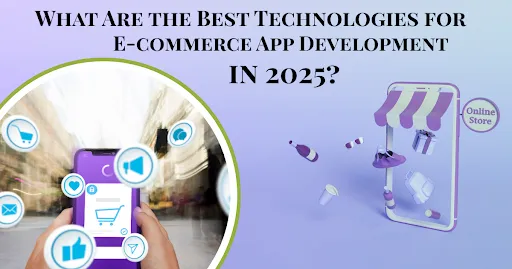
What Are the Best Technologies for E-commerce Application Situation in 2025?
The eCommerce platform is evolving at a rapid speed.
There are numerous shifts to it, and we’re witnessing groundbreaking transformations in how businesses can connect with their customers digital.
Tech has built the world differently, from intuitive mobile interfaces to AI-driven personalization and lightning-quick checkout experiences.
These advanced technologies are the powerhouse that shapes the future effortlessly.Statista states global e-commerce sales will likely reach $8.1 trillion by 2026, making it a winning situation.As the technologies are mastered, so numerous technologies and tools are in the market.
In this rapid race, a question arises ‘what are the best technologies and frameworks flooding the digital space?In this blog, we’ll walk you through the most powerful technologies and trends setting recent standards for e-commerce platform situation.What are Those Tools & Technologies That Set You Apart?So numerous excellent tools and technologies are floating in the market that can implant the seed of a recent beginning with reliable & secure methods. 1) Headless CommerceHeadless commerce is no longer a buzzword, it is the norm.
In this tech architecture, the front conclude is decoupled from the backend, which allows brands to build a highly customizable and consumer-friendly platform.Why is it taking the front seat?Headless commerce excites users and helps them overcome their pain points.
It proposals interestingly like;Faster loading speedsPersonalized UI across several platforms (Mobile, Web, Smart TVs, Wearables)Seamless integrations with CMS, CRMs, and third-party tools.Tech Stack Examples:Frontend: React.js, Vue.js, Next.jsBackend: Node.js, GraphQL, REST APIsHeadless CMS: Strapi, Contentful, SanityDo you understand why this tech stands?
Because 60% of e-commerce companies are expected to adopt headless architecture to meet the growing demands by 2025.2) Progressive Web Apps (PWAs)These are the intriguing things that happened, as they combine the capabilities of native mobile apps with the reach of the web.
They offer offline functionality, quick loading times, and an application-like experience without downloading any application.Why Businessmen tend towards it?Improved SEO and discoverabilityReduced Situation Costs (One Application for all devices)Higher Conversion ratesPopular Tech that has been usedAngular, React, Vue.JsService WorkersWeb Application ManifestThis latest tech reported increased conversation rates for recent users being open to adopting PWA.3) Artificial Intelligence & Machine LearningThe AI & ML game is so powerful, transforming static shopping experience into dynamic.
It enabled AI chatbots to make smart product recommendations and detect fraud.
AI gives the main character a feeling to the businesses as it drives customer engagement and retention like never before.How Helpful can AI & ML be in e-commerce?Predictive search and smart filtersPersonalized product recommendations (Based on behavior, previous past, and preferences)AI-based chatbots for 24/7 aid.Frameworks and ToolsTensorFlow, PyTorch, OpenAI APIsDialog Flow, IBM WatsonRecommendation Engines (AWS Personalize, Google Recommendations AI)As per the survey, 70% of digital consumers expect personalization.
For that sake, companies are adopting the AI model, which led to a 30% rise in productivity (McKinsey & Firm).4) Augmented Reality (AR) & Virtual Try-On TechnologyVisualizing products before buying them has become a standard.
To maintain this, AR-powered e-commerce apps offer diverse real-world products to test.
The main focus area on this is fashion, home decor, and beauty categories.Did you understand several real-world examples of it?
These are the IKEA Place application (Try furniture in your room via AR), Sephora Virtual Artist (Try on makeup virtually), Lenskart (Virtual Eyewear Try-On)AR Toolkits:ARKit (iOS)ARCore (Android)WebAR and 8thWall (for browser-based AR)You can get the right thing at your place through this advanced method.
In eCommerce, it is forecasted to reach $10 billion in market value by 2027 (Statista)5) Voice Commerce- Shop with CommandsYour voice has a lot of volume, so what if it becomes the practicality for each one.
Smart speakers and voice assistants have become everyday things in the market.
You can give commands through virtual assistance to make the smart purchase without putting in a lot more effort.Why Does it Matter?Hands-free shoppingFaster checkout with voice commandsVoice search optimizationIntegration Tools:Google Assistant SDKAmazon Alexa Voice ServicesApple SiriKitIt is predictable, as voice-based shopping is projected to hit $40 billion in the U.S.
Alone.6) Blockchain is known for its Transparency, Protection, and decentralized nature.Blockchain tech is making eCommerce platforms more secure, transparent, and efficient.
From smart contracts to secure payment and supply chains, it is reshaping the e-commerce platform silently.Key BenefitsFraud-Proof TransactionsDecentralized payment systems (Crypto wallets, NFTs)Transparent supply chains and provenance trackingPopular Tools & Platforms:Ethereum, Hyperledger, SolanaSmart Contract Tools: Solidity, TruffleWallet Integration APIs (Metamask, Coinbase)81% of eCommerce businesses believe blockchain can enhance payment protection and prevent fraud (PwC Survey)7) Cloud ComputingCloud tech empowers e-commerce platforms to scale effortlessly while maintaining performance and protection.Why is Cloud a Must in nowadays’s Scenario?Scalable infrastructureGlobal content deliveryData backups and disaster recoveryBetter performance and uptimeCloud Service Providers:Amazon Web Services (AWS)Google Cloud Platform (GCP)Microsoft AzureMigrating to the cloud can reduce IT costs by up to 30% and improve load time by 70% (IBM Study).8) Mobile-Initially and Cross-Platform DevelopmentThe mobile-initially approach is not a desire but comes as a necessity.
As per Statista, 72.9% of all eCommerce sales are driven by mobile devices.
In this case, optimizing those mobile screens for the consumer’s ease became mandatory.Additionally, cross-platform situation ensures businesses can easily target iOS and Android users simultaneously without building separate apps.What are those well-known frameworks?Flutter (Google)React Native (Meta)Kotlin MultiplatformKey Features:Faster time-to-marketUnified codebaseNative-like performanceIn short, cross-platform apps are there to save 40% on situation costs on average compared to native situation.9) Real-Time Analytics and Major DataData is the heart of modern eCommerce.
With advanced tools like real-time analytics, real-time information can easily track customer behavior and predict trends that assist to make information-driven decisions.What are the Benefits of Real-Time Analytics:It helps to optimize marketing campaigns.Inventory and supply chain insightsPersonalized promotionsPopular Tools:Google Analytics 4Mixpanel, AmplitudeBigQuery, Apache HadoopThose companies that are using real-time analytics are intended to experience 23X better customer acquisition rates and 6X better retention rates (Aberdeen Group).10) Cybersecurity TechnologiesCyber threats are growing day by day.
To secure eCommerce, they are built differently to tackle all those threats.
Customers are intrigued to shop with the brands that ensure information protection and prevent them from any sort of fraud.The Must-Have Protection Technologies:Conclude-to-conclude encryption (SSL/TLS)Multi-factor authenticationTokenization and biometric securityCompliance with GDPR, CCPA, PCI DSSThe damage from cybercrime is expected to reach $ 10.5 trillion annually by 2025 (Cybersecurity Ventures).
Nevertheless, Investing in protection is not a choice but a survival strategy in the tech-based market.Finally…The technologies you choose nowadays will craft your success in this rapidly growing and competitive environment.
Whether headless architecture, AI personalization, AR experiences, or blockchain-backed protection, staying on top of the trends pays you well.So, if you strategy to launch or revamp an eCommerce platform in 2025, choose a relevant, modern tech stack.
Make sure it is secure, scalable, customer-focused, and future-ready, which develops you stand out in the market.Author’s Bio:Priyanka Sharma is the author of this article.
She is a software engineer at CodeAegis with 5+ years of experience.
Apart from situation, she loves to share insights about tech and business tech aid through articles and blogs.


















